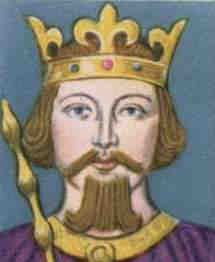King William Rufus of Normandy II 1
His harsh rule aroused baronial and acclesiastical opposition, notably from Anselm, Archbishop of Canterbury. He made several attempts to recover Normandy from his elder brother Robert and was killed by an arrow while hunting. He may have been assasinated by order of his younger brother who became Henry I. Had Red Hair. He had very little time for religion and presided over a liberal court but treated his subjects brutally. He was reluctant to fill church vacancies and waited 4 years to apoint Anselm. -------- William II earned the nickname Rufus either because of his red hair or his propensity for anger. William Rufus never married and had no offspring. The manner in which William the Conqueror divided his possessions caused turmoil among his sons: his eldest son Robert received the duchy of Normandy, William Rufus acquired England, and his youngest son Henry inherited 5000 pounds of silver. The contention between the brothers may have exerted an influence on the poor light in which William Rufus was historically portrayed. Many Norman barons owned property on both sides of the English Channel and found themselves in the midst of a tremendous power play. Hesitant to declare sides, most of the barons eventually aligned with Robert due to William Rufus' cruelty and avarice. Robert, however, failed to make an appearance in England and William Rufus quelled the rebellion. He turned his sights to Normandy in 1089, bribing Norman barons for support and subsequently eroding his brother's power base. In 1096, Robert, tired of governing and quarreling with his brothers, pawned Normandy to William Rufus for 10,000 marks to finance his departure to the Holy Land on the first Crusade. Robert regained possession of the duchy after William Rufus' death in 1100. William Rufus employed all the powers of the crown to secure wealth. He manipulated feudal law to the benefit of the royal treasury: shire courts levied heavy fines, confiscation and forfeitures were harshly enforced, and exorbitant inheritance taxes were imposed. His fiscal policies included (and antagonized) the church - William Rufus had no respect for the clergy and they none for him. He bolstered the royal revenue by leaving sees open and diverting the money into his coffers. He treated the Church as nothing more than a rich corporation deserving of heavy taxing at a time when the Church was gaining in influence through the Gregorian reforms of the eleventh century. Aided by his sharp-witted minister, Ranulf Flambard, William Rufus greatly profited from clerical vacancies. The failed appointment and persecution of Anselm, Abbot of Bec, as the Archbishop of Canterbury in 1093 added fuel to the historical denigration of William II; most contemporary writings were done by monks, who cared little for the crass, blasphemous king. On August 2, 1100, William Rufus was struck in the eye by an arrow and killed while hunting. Whether the arrow was a stray shot or premeditated murder is still under debate. 1066 and All That, a satire on medieval government, remembers William II in a unique manner: "William Rufus was always very angry and red in the face and was therefore unpopular, so that his death was a Good Thing."
• Title, 26 Sep 1087, Westminster Abbey, London, England. 3 King of England |


 General Notes:
General Notes: